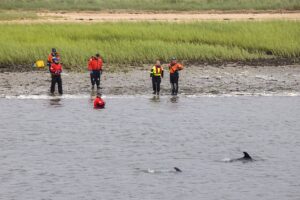WELLFLEET — Last week’s mass dolphin stranding here is thought to be the largest in at least a quarter century, and its causes may never be fully explained.

One hundred twenty-five Atlantic white-sided dolphins were found beached in the area between the Herring River and Great Island known as “the Gut” on the morning of June 28. Staff and volunteers with the International Fund for Animal Welfare (IFAW) rushed to Wellfleet from across the Cape to help. Ten of the animals had already died before rescue teams arrived.
Scott Landry, director of the marine animal entanglement response team at the Center for Coastal Studies in Provincetown, told the Independent that determining why dolphins strand this way is the “million-dollar question that we don’t have answers for.”
Dolphins are highly social animals, Landry said, “so, people tend to think that because one animal strands, the rest of the group will strand with them.” He thinks the pod likely came into Cape Cod Bay to feed on herring and menhaden. The Atlantic white-sided dolphin typically spends most of its life in deep water far from the coast.
Stacey Hedman, IFAW’s director of communications, said the event was the largest of its kind in at least 25 years, but strandings are common in Wellfleet, especially around the mouth of the Herring River and Wellfleet Harbor. IFAW has 150 trained volunteers on Cape Cod and responded to 268 strandings last year in southeastern Massachusetts.
“Cape Cod is a hook and Wellfleet is another hook within that,” said Hedman. “They’re not sick; it’s not climate change. We do this nearly every week, or definitely a couple of times per month.”
IFAW responded in April to the stranding of 11 Atlantic white-sided dolphins in Wellfleet, three of which were in the Gut. Ten dolphins were saved after a seven-hour rescue operation.
A Community Effort
During last Friday’s efforts, at least 25 IFAW staff and 100 volunteers raced out onto the flats. Dolphins that were completely out of the water were covered with damp sheets to keep them wet and protect them from sunburn. Volunteers flipped partially submerged dolphins, which can weigh up to 500 pounds, to make sure their blowholes were out of the water and prevent them from drowning.

In addition to the IFAW teams, rescuers from the Center for Coastal Studies, AmeriCorps of Cape Cod, the New England Aquarium, and Plymouth-based Whale and Dolphin Conservation came to help. Some nearby homeowners donated sheets and offered their laundry machines to muddy responders. At one point, there were not enough flotation devices to match the number of people willing to go into the rising water.
Jerry Houser, who was visiting from Los Angeles and renting a house on Chequessett Neck Road with friends, saw the scene unfold from the porch where his group had been drinking coffee and looking over the Gut. He said it went from a “beautiful, serene thing with dolphins swimming in the water” to what “ended up looking like a war zone when all the water was gone.” By noon, their back yard had become the headquarters for the animal response teams.
Misty Niemeyer, the on-scene incident commander for IFAW, said if the number of dolphins stranded had been smaller, she would have tried to extract them using a mobile rescue unit, which can hold up to nine animals at once. But because there were so many, she instructed her team to provide supportive care while waiting for high tide.
By 2:15 p.m., the Gut had filled again with water deep enough that the dolphins could swim. From shore, volunteers could see pods looking for an escape route but sometimes swimming in the wrong direction. IFAW staff and volunteers waded in, splashing at groups venturing close to shore to drive them back into deeper water.
By 3 p.m., a team of IFAW staff, Wellfleet Harbor workers, and paddleboarders began to herd the dolphins out of the channel and toward the harbor. They used boat engines and underwater noisemakers and slapped the water with their hands, according to Brittany Tilton, a staff member at the harbormaster’s office. Their efforts continued all afternoon.

“We went until the sun set, and we couldn’t see fins anymore,” said Tilton. By the end of the day, Tilton said most of the dolphins appeared to have made it out. At sunrise the next morning, however, IFAW volunteers were back, trying to save dolphins found stuck in the shallow waters near the Wellfleet pier.
The operation carried over into day three on Sunday as IFAW returned to assist six or seven dolphins still in Wellfleet Harbor. One dolphin “was in poor condition,” so IFAW responders “humanely euthanized” it, according to a statement from Katie Moore, IFAW’s deputy vice president of rescue.
“This is not only important for the welfare of that animal, but also helps us to be more successful in herding the remaining animals out,” Moore wrote. “The very social nature of these dolphins means that they will stick together even in a bad situation. By removing individuals that are not well, the group may be more easily moved offshore.”
Hedman said the dead dolphins’ bodies often undergo necropsies and are sometimes donated to universities.
On Sunday afternoon, IFAW responded to another stranding of about 20 dolphins in Brewster. Three had died of natural causes before they arrived. IFAW Director Brian Sharp said it was considered part of the same mass stranding, as some of the dolphins in Brewster on Sunday were part of the group in Wellfleet on Friday.
An Emotional Toll
All IFAW volunteers must complete a nine-hour training course and attend annual refreshers. Still, many volunteers appeared stunned by the sheer number of stranded animals.

“I don’t pray, but if you do, it’s not a bad thing to do,” said IFAW volunteer Jeff Blaustein, who was watching the scene as the tide came in. “It’s heartbreaking.
“People say, ‘Are they stupid? Why do they get stuck? Why do they get stranded?’ ” said Blaustein. “You ever kayak here? I kayak here every day. And I get lost over there, and I don’t know which way is out.”
Jacob Dalby, the farm manager of Holbrook Oyster who often harvests in the waters near Great Island, said the area near the Gut can go from about 10 feet deep to just sand and mud quickly.
“The tides are fairly extreme right now,” said Dalby. “It rushes out and rushes back in.”
Animal strandings have long been a fact of daily life in Wellfleet. According to Dalby, Blackfish Creek in South Wellfleet is named after the pilot whales that used to strand there.
“It was a huge community event when it happened,” said Dalby. “Everyone would hit the beach and start rendering all the fat when this happened 100 years ago.”
Last weekend proved that strandings are still a community event, even if the reason for the people coming together has changed completely.



